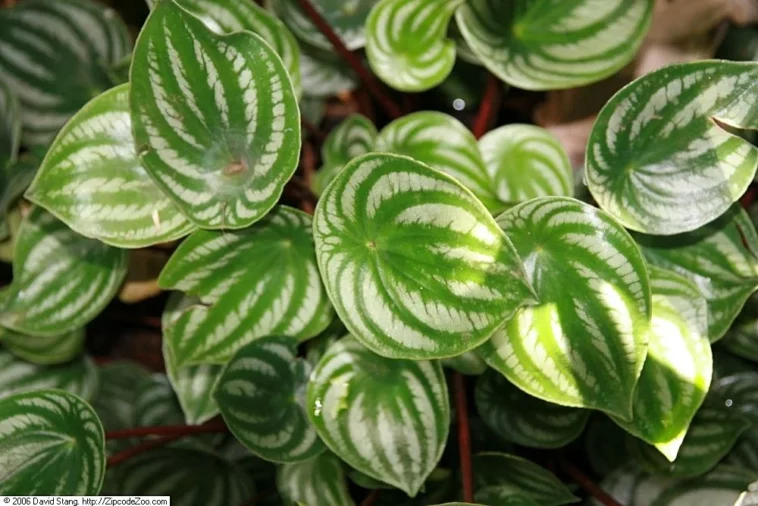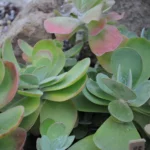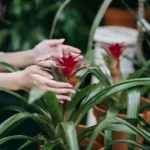Table of Contents
Caring for Watermelon Peperomia
The Watermelon Peperomia, or Peperomia Argyreia, is a very pretty little plant whose leaves look a lot like watermelon rinds.
It’s popular for that appearance, and also because it’s a relatively easy houseplant to care for compared to many tropical plants. The purple stalks help add to the tropical, exotic impression.
Watermelon Peperomia generally stays under ten inches tall. The leaves reach out over its pot, so some people in warm climates prefer to keep these plants outdoors like tiny bushes.
This plant also looks great in a collection of other tropical plants, and keeping tropical plants together tends to make caring for them easier, since they all have very similar needs.
Helping Watermelon Peperomia Thrive
The Watermelon Peperomia enjoys warmth and humidity and will do best under these conditions. It also likes bright, indirect light, just like most smaller tropical plants.
Given the right conditions, the Watermelon Peperomia will have beautiful leaves with pronounced watermelon-like markings.
Keep an eye on the leaves for signs that something in the Watermelon Peperomia’s environment needs to be changed. Warning signs include yellow leaves, too pale of leaves, too dark of leaves, or browning leaves.
The Watermelon Peperomia likes to be a bit root bound rather than having a lot of extra room in the pot, so it really doesn’t need repotting often.
Light Requirements
The responsive leaves on the Watermelon Peperomia will help you get its lighting just right. It likes bright, indirect light, as it would receive in shady portions of an otherwise well-lit area.
If the leaves start getting too pale, that means the plant is getting too much light. If the leaves start getting too dark, that means it’s not getting enough light.
Having it near a window that gets a lot of light is generally ideal, as long as you’re careful not to allow much direct light to actually touch the Watermelon Peperomia.
Temperature Requirements
The Watermelon Peperomia likes warm temperatures but is comfortable in average indoor temperatures. It can do well in temperatures from 65 degrees Fahrenheit to 80 degrees Fahrenheit. At the lower end of the range, growth will slow.
If you have to go outside of the Watermelon Peperomia’s comfort range, it’s better to err on the side of too much warmth rather than too much cold.
If you keep the Watermelon Peperomia outdoors in a temperate or cool region, be sure that it’s kept in a pot so it can be brought inside when temperatures dip near or below 60 degrees.
Soil Requirements
The Watermelon Peperomia does best with a well-draining, loose soil. The goal is to have it in soil that retains moisture well without drowning the roots or causing root rot.
One good combination is a soil mix with peat and perlite, which holds on to some moisture while letting the water drain.
Be sure that any pot has good drainage and that excess water has a place to escape rather than staying against the roots.
Humidity Requirements
The Watermelon Peperomia likes humidity, but it can survive in average humidity, too. If it seems too dry or if you live in a dry climate, consider using a pebble tray, setting out plates of water, or watering plants close together.
These are all inexpensive ways to increase the ambient humidity near the plant. You can also invest in a humidifier, especially if you are fond of tropical plants.
Another option is to keep the plant in a bathroom if your bathroom has enough light for the Watermelon Peperomia to thrive; it will love the humidity caused by the shower.
How to Water
It’s important not to overwater the Watermelon Peperomia. Before watering, check the top inch or two of soil.
If this is dry, it’s a good time to water the plant. If not, you can wait a little longer. Depending on your climate and the time of year, this Is usually between five and ten days.
Yellowing, washed-out leaves indicate that the plant is getting too much water. If the roots stay too wet for too long, the plant may develop root rot and start turning black at the stems.
It’s nearly impossible to rescue a plant once it has started rotting, so avoidance is the best policy.
Thin, weak leaves can indicate that a plant isn’t getting enough water. Make sure the soil mix is suitable for staying moist.
How to Fertilize
Use a well-balanced fertilizer once a month during Watermelon Peperomia’s growing season of spring and summer. Dilute the fertilizer to half strength before applying.
Extra Tips for the Paddle Plant
Pruning
The Watermelon Peperomia doesn’t typically need a lot of pruning. As with any plant, it’s a good idea to remove dead or damaged leaves.
You can also do some light pruning once a year, especially if the plant is getting a little leggy or if you’d like to try propagating it.
Propagation
Watermelon Peperomia is best propagated by cutting. Take a cutting with at least one leaf and at least an inch of stem. You can use a root hormone to encourage growth before planting the cutting in moist soil.
Pests and Diseases
The Watermelon Peperomia isn’t particularly prone to pests or diseases.
As with any plant, it’s best to avoid root rot rather than trying to treat it. Make sure the plant has plenty of drainage and that its soil stays moist, not wet.
Ridding Watermelon Peperomia of Pests
All plants can get pests on occasion. The best way to rid plants of pests is to wipe down any visible signs of infestation such as webs, bugs, or eggs.
Check especially under leaves, near the stem. You can then treat the plant and any nearby plants with a gentle insecticide or neem oil.
Toxicity
The Watermelon Peperomia is non-toxic, which makes it one of the safer plants to keep around pets and children.
Quick Reference
- Light: Bright and indirect
- Temperature: 65 to 80 degrees Fahrenheit
- Soil: Well-draining and loose
- Humidity: Average to high
- Water: When top soil is dry
- Pruning: Light pruning annually
Photo by David J. Stang, CC BY-SA 4.0 https://creativecommons.org/licenses/by-sa/4.0, via Wikimedia Commons


